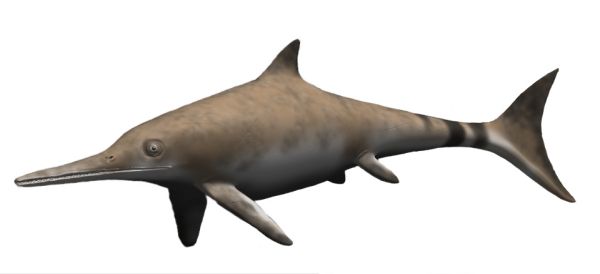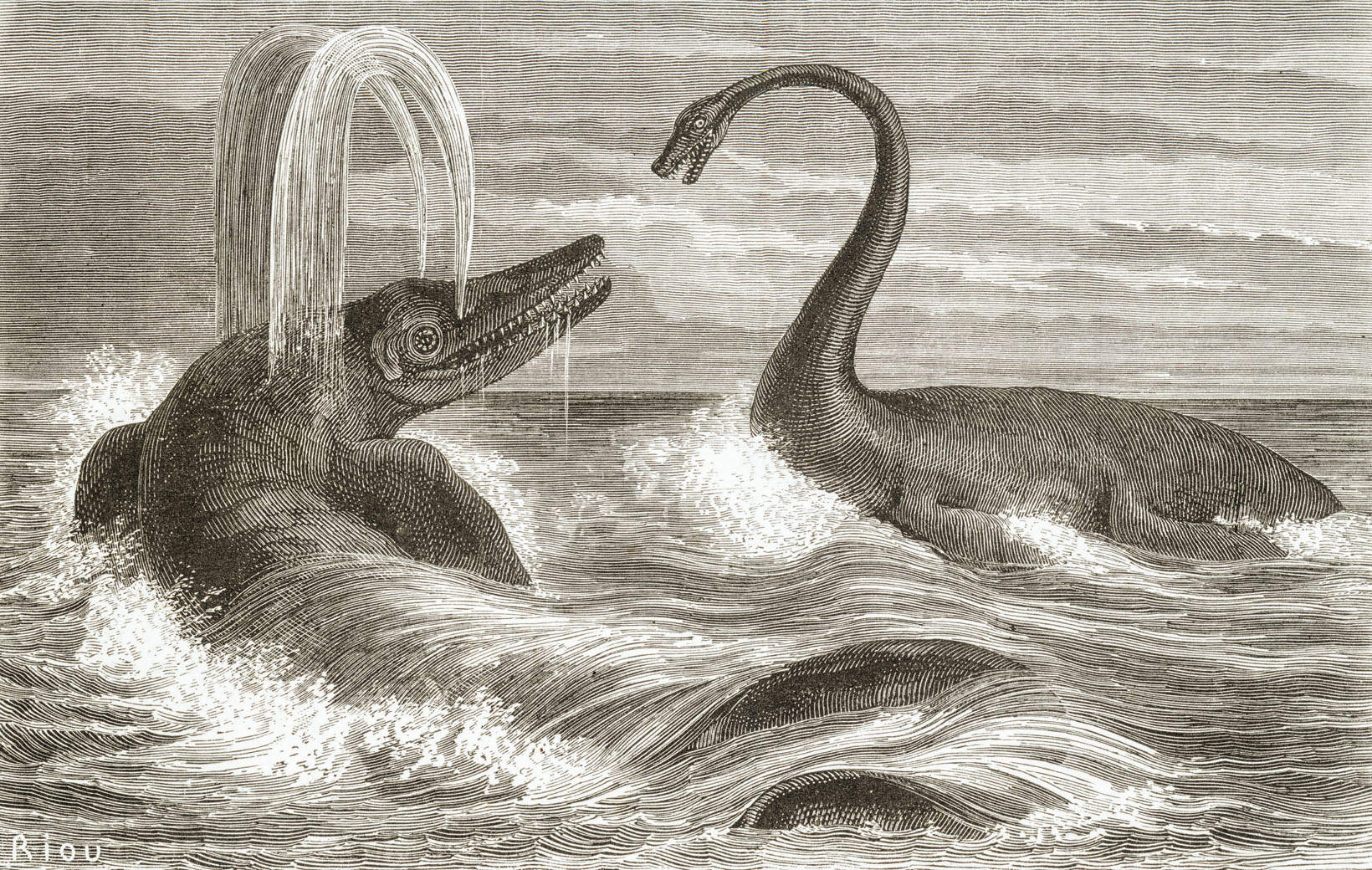|
Ophthalmosauridae
Ophthalmosauridae is an extinct family of thunnosaur ichthyosaurs from the Middle Jurassic to the early Late Cretaceous (Bajocian - Cenomanian) worldwide. Almost all ichthyosaurs from the Middle Jurassic onwards belong to the family, until the extinction of ichthyosaurs in the early Late Cretaceous. Ophthalmosaurids appeared worldwide during early Bajocian, subsequent to the disappearance of most other ichthyosaur lineages after the end of the Toarcian. Currently, the oldest known ophthalmosaurids is ''Mollesaurus'' from the early Bajocian of Argentina, as well as indeterminate remains of the same age from Luxembourg and Canada. Named by George H. Baur, in 1887, the family contains the basal taxa like ''Ophthalmosaurus''. Appleby (1956) named the taxon Ophthalmosauria which was followed by some authors, but these two names are often treated as synonyms; Ophthalmosauridae has the priority over Ophthalmosauria. However, some researchers argue that Ophthalmosauridae should be restrict ... [...More Info...] [...Related Items...] OR: [Wikipedia] [Google] [Baidu] |
Arthropterygius
''Arthropterygius'' is a widespread genus of ophthalmosaurid ichthyosaur which existed in Canada, Norway, Russia, and Argentina from the late Jurassic period and possibly to the earliest Cretaceous. Description ''Arthropterygius'' appears to have been a relatively large ichthyosaur, with all species measuring between long. The partially preserved specimen PMO 222.655 has been estimated at based on comparisons to the contemporary ophthalmosauridae, ophthalmosaurid ''Undorosaurus''. This specimen was probably mature or close to maturity at time of death, judging by the convex head of the humerus and the smooth texture of the humeral shaft. Skull and axial skeleton The skull of ''Arthropterygius'' has become well known due to the discovery of a well preserved skull from Svalbard. It is unusual among ichthyosaurs in having a very short, yet also robust rostrum for its skull length. As a result, the orbit appears very large (about 0.34× the skull length). The skull bears a very l ... [...More Info...] [...Related Items...] OR: [Wikipedia] [Google] [Baidu] |
Muiscasaurus
''Muiscasaurus'' is an extinct genus of ophthalmosaurid ichthyosaur that lived in modern Colombia during the Early Cretaceous. The only known species is the type ''Muiscasaurus catheti''. Discovery The fossils of ''Muiscasaurus'' were found in the Paja Formation, whose sediments are exposed near the town of Villa de Leyva in Boyacá Department. These remains were found in 2010 in the middle of a limestone concretion, known as the Arcillolitas abigarradas Member, dating from the Barremian to Aptian epochs of the Lower Cretaceous. Although ammonites were found attached to the fossils, their poor preservation prevented identifying them and thereby establish the stratigraphy and precise age of the specimen. The fossil found, listed as the holotype specimen CIP-FCG-CBP-74, consists of a partial skull and some vertebrae with ribs that were found associated with the skull. These remains were designated in 2015 as the new genus and species ''Muiscasaurus catheti''; the genus name being ... [...More Info...] [...Related Items...] OR: [Wikipedia] [Google] [Baidu] |
Ophthalmosaurus Icenicus Updated Reconstruction
''Ophthalmosaurus'' (Greek ὀφθάλμος ''ophthalmos'' 'eye' and σαῦρος ''sauros'' 'lizard') is a genus of ichthyosaur known from the Middle-Late Jurassic. Possible remains from the earliest Cretaceous, around 145 million years ago, are also known. It was a relatively medium-sized ichthyosaur, measuring long and weighing . Named for its extremely large eyes, it had a jaw containing many small but robust teeth. Major fossil finds of this genus have been recorded in Europe with a second species possibly being found in North America. Description ''Ophthalmosaurus'' was a medium-sized ichthyosaur, growing to measure in length and weighing between . It had a robust, streamlined body that was nearly as wide as it was tall in frontal view. Like other derived ichthyosaurs ''Ophthalmosaurus'' had a powerful tail ending in a pronounced bi-lobed caudal fluke whose lower half was formed around the caudal spine whereas the upper lobe was made up entirely from soft tissue. The ... [...More Info...] [...Related Items...] OR: [Wikipedia] [Google] [Baidu] |
Keilhauia
''Keilhauia'' is a genus of ophthalmosauridae, ophthalmosaurid Ichthyosauria, ichthyosaur, a type of dolphin-like, large-eyed marine reptile, from the Early Cretaceous shallow marine Slottsmøya Member of the Agardhfjellet Formation in Svalbard, Norway. The genus contains a single species, ''K. nui'', known from a single specimen discovered in 2010 and described by Delsett ''et al.'' in 2017. In life, ''Keilhauia'' probably measured approximately in length; it can be distinguished by other ophthalmosaurids by the wide top end of its ilium (bone), ilium and the relatively short ischiopubis (the fusion of the ischium and the pubis (bone), pubis) compared to the femur. Although it was placed in a basal position within the Ophthalmosauridae by phylogenetics, phylogenetic analysis, this placement is probably incorrect. Description Judging by the partially preserved holotype specimen, ''Keilhauia'' has been estimated at based on comparisons to the related ophthalmosauridae, ophthalm ... [...More Info...] [...Related Items...] OR: [Wikipedia] [Google] [Baidu] |
Brachypterygius
''Brachypterygius'' (meaning ″short wing/paddle″ in Greek) is an extinct genus of platypterygiine ophthalmosaurid ichthyosaur known from the Late Jurassic of England.McGowan, C. & Motani, R. ''Ichthyopterygia''. In Sues, H.-D. (ed.) Handbook of Paleoherpetology, vol. 8. Verlag Dr. Friedrich Pfeil, Munich, 175 pp., 19 pls. The type species was originally described and named as ''Ichthyosaurus extremus'' by Boulenger in 1904.Boulenger, G. A. 1904. Exhibition of, and remarks upon, a paddle of a new species of ichthyosaur. ''Proceedings of the Zoological Society of London'', 1904, 424–426. ''Brachypterygius'' was named by Huene in 1922 for the width and shortness of the forepaddle, and the type species is therefore ''Brachypterygius extremus''.Huene, F. F. von 1922. ''Die Ichthyosaurier des Lias und ihre Zusammenhänge''. Verlag von Gebrüder Borntraeger, Berlin, 114 pp., 22 pls. The holotype of ''B. extremus'' was originally thought to be from the Lias Group of Bath, United Ki ... [...More Info...] [...Related Items...] OR: [Wikipedia] [Google] [Baidu] |
Myobradypterygius
''Myobradypterygius'' is an extinct genus of ophthalmosaurid ichthyosaur from the Early Cretaceous (Barremian-Hauterivian) of Argentina and possibly also Chile. One species is known, ''M. hauthali'',Huene, F. von. (1927). Beitrag zur Kenntnis mariner mesozoischer Wirbeltiere in Argentinien. ''Centralblatt für Mineralogie, Geologie und Paläontologie, B'' 1927:22-29. which was once believed to have been a species of ''Platypterygius''.McGowan, C. (1972). The systematics of Cretaceous ichthyosaurs with particuliar reference to the material from North America. ''Contributions to Geology.'' 1972;11:9–29. ''Myobradypterygius'' is thought to have been a small ichthyosaur, with an estimated total body length of . Discovery and naming The holotype, MLP 79-I-30-2, a vertebral column and associated forelimbs, was discovered between 1900 and 1925 by Rudolph Hauthal at Nevado de Famatina, Argentina. The specimen was first described by Friedrich von Huene, von Huene (1925) and he reconst ... [...More Info...] [...Related Items...] OR: [Wikipedia] [Google] [Baidu] |
Thunnosaur
Thunnosauria (Greek for "tuna lizard" – ''thunnos'' meaning "tuna" and ''sauros'' meaning "lizard") is an extinct clade of parvipelvian ichthyosaurs from the Early Jurassic to the early Late Cretaceous (Hettangian–Cenomanian) of Asia, Australia, Europe, North America, and South America. Named by Ryosuke Motani in 1999, it contains the basal taxa '' Ichthyosaurus'' and '' Stenopterygius'' and the family Ophthalmosauridae. In thunnosaurs, the fore fin is at least twice as long as the hind fin. Phylogeny Thunnosauria is a node-based taxon defined in 1999 as "the last common ancestor of '' Ichthyosaurus communis'' and '' Stenopterygius quadriscissus'' and all of its descendants". The cladogram A cladogram (from Greek language, Greek ''clados'' "branch" and ''gramma'' "character") is a diagram used in cladistics to show relations among organisms. A cladogram is not, however, an Phylogenetic tree, evolutionary tree because it does not s ... below follows the topology from a ... [...More Info...] [...Related Items...] OR: [Wikipedia] [Google] [Baidu] |
Ichthyosaurs
Ichthyosauria is an taxonomy (biology), order of large extinction, extinct marine reptiles sometimes referred to as "ichthyosaurs", although the term is also used for wider clades in which the order resides. Ichthyosaurians thrived during much of the Mesozoic era; based on fossil evidence, they first appeared around 250 million years ago (Myr, Ma) and at least one species survived until about 90 million years ago, into the Late Cretaceous. During the Early Triassic Geologic time scale, epoch, ichthyosaurs and other Ichthyosauromorpha, ichthyosauromorphs evolved from a group of unidentified land reptiles that returned to the sea, in a development similar to how the mammalian land-dwelling ancestors of modern-day dolphins and whales returned to the sea millions of years later, which they gradually came to resemble in a case of convergent evolution. Ichthyosaurians were particularly abundant in the Late Triassic and Early Jurassic periods, until they were replaced as the top ... [...More Info...] [...Related Items...] OR: [Wikipedia] [Google] [Baidu] |
Thunnosauria
Thunnosauria (Ancient Greek, Greek for "tuna lizard" – ''thunnos'' meaning "tuna" and ''sauros'' meaning "lizard") is an extinct clade of parvipelvian ichthyosaurs from the Early Jurassic to the early Late Cretaceous (Hettangian–Cenomanian) of Asia, Australia, Europe, North America, and South America. Named by Ryosuke Motani in 1999, it contains the basal taxa ''Ichthyosaurus'' and ''Stenopterygius'' and the family Ophthalmosauridae. In thunnosaurs, the fore fin is at least twice as long as the hind fin. Phylogeny Thunnosauria is a node-based taxon defined in 1999 as "the last common ancestor of ''Ichthyosaurus communis'' and ''Stenopterygius quadriscissus'' and all of its descendants". The cladogram below follows the topology from a 2010 analysis by Patrick S. Druckenmiller and Erin E. Maxwell. References Hettangian first appearances Ichthyosauria Turonian extinctions {{ichthyosaur-stub ... [...More Info...] [...Related Items...] OR: [Wikipedia] [Google] [Baidu] |



